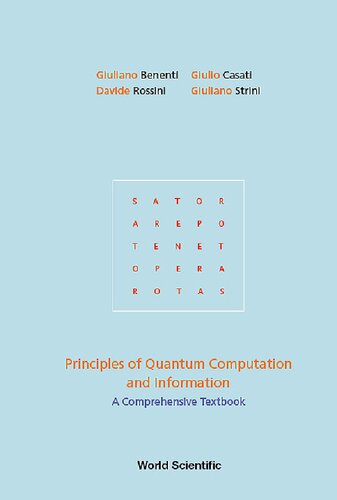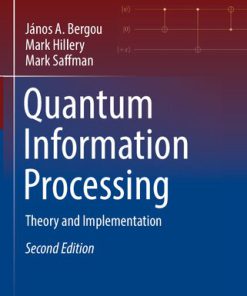Principles of Quantum Computation and Information 2nd Edition by Giuliano Benenti, Giulio Casati, Davide Rossini, Giuliano Strini ISBN 9789813237223 9813237228
$50.00 Original price was: $50.00.$25.00Current price is: $25.00.
Principles of Quantum Computation and Information 2nd Edition by Giuliano Benenti, Giulio Casati, Davide Rossini, Giuliano Strini – Ebook PDF Instant Download/Delivery: 9789813237223 ,9813237228
Full download Principles of Quantum Computation and Information 2nd Edition after payment

Product details:
ISBN 10: 9813237228
ISBN 13: 9789813237223
Author: Giuliano Benenti, Giulio Casati, Davide Rossini, Giuliano Strini
Principles of Quantum Computation and Information 2nd Edition Table of contents:
1. Introduction to classical computation
1.1 The Turing machine
1.1.1 Addition on a Turing machine
1.1.2 The Church–Turing thesis
1.1.3 The universal Turing machine
1.1.4 The probabilistic Turing machine
1.1.5 ⋆ The halting problem
1.2 The circuit model of computation
1.2.1 Binary arithmetics
1.2.2 Elementary logic gates
1.2.3 Universal classical computation
1.3 Computational complexity
1.3.1 Tractable vs
1.3.2 Complexity classes
1.3.3 ⋆ The Chernoff bound
1.4 ⋆ Computing dynamical systems
1.4.1 ⋆ Deterministic chaos
1.4.2 ⋆ Algorithmic complexity
1.5 Energy and information
1.5.1 Maxwell’s demon
1.5.2 Landauer’s principle
1.5.3 Extracting work from information
1.6 Reversible computation
1.6.1 Toffoli and Fredkin gates
1.6.2 ⋆ The billiard-ball computer
1.7 ⋆ Energy dissipation in computation
1.7.1 ⋆ Experimental realization of a Maxwell’s demon
1.7.2 ⋆ Experimental verification of Landauer’s principle
1.7.3 ⋆ Energy dissipation in real classical computer
1.7.4 ⋆ Experimental realization of reversible computers
1.7.5 ⋆ Neuromorfic computing
1.8 A guide to the bibliography
2. Introduction to quantum mechanics
2.1 The Stern–Gerlach experiment
2.2 Young’s double-slit experiment
2.3 The postulates of quantum mechanics
2.3.1 Dynamical evolution
2.3.2 Outcomes of a measurement
2.3.3 The post-measurement state
2.3.4 Heisenberg’s uncertainty principle
2.4 The EPR paradox
2.5 Bell’s inequalities
2.6 The density matrix
2.6.1 Composite systems
2.7 The Schmidt decomposition
2.8 Purification
2.9 Generalized measurements
2.9.1 POVM measurements
2.10 A guide to the bibliography
3. Quantum computation
3.1 The qubit
3.1.1 Pure qubit states: The Bloch sphere
3.1.2 Mixed qubit states: The Bloch ball
3.2 Measuring the state of a qubit
3.2.1 Pure qubit states
3.2.2 Mixed qubit states
3.3 The circuit model of quantum computation
3.4 Single-qubit gates
3.4.1 Rotations of the Bloch sphere
3.5 Controlled gates and entanglement generation
3.5.1 The Bell basis
3.6 Hamiltonian model for one- and two-qubit gates
3.7 Universal quantum gates
3.7.1 ⋆ Preparation of the initial state
3.8 Unitary errors
3.9 Function evaluation
3.10 ⋆ The quantum adder
3.11 Adiabatic theorem
3.11.1 Adiabatic condition
3.11.2 Berry phase
3.12 ⋆ Non-Abelian geometric phase
3.13 Adiabatic quantum computation
3.14 ⋆ Maximum speed of quantum gates
3.14.1 ⋆ Speed limit of an autonomous time evolution
3.14.2 ⋆ Speed limit of single-qubit gates
3.15 ⋆ Holonomic quantum computation
3.16 A guide to the bibliography
4. Quantum algorithms
4.1 Deutsch’s algorithm
4.1.1 The Deutsch–Jozsa problem
4.1.2 ⋆ An extension of Deutsch’s algorithm
4.2 Quantum search
4.2.1 Searching one item out of four
4.2.2 Searching one item out of N
4.2.3 Geometric visualization
4.2.4 Searching by adiabatic quantum evolution
4.3 The quantum Fourier transform
4.4 Quantum phase estimation
4.5 ⋆ Finding eigenvalues and eigenvectors
4.6 Period finding and Shor’s algorithm
4.7 Quantum computation of dynamical systems
4.7.1 Quantum simulation of the Schrödinger equation
4.7.2 ⋆ The quantum baker’s map
4.7.3 ⋆ The quantum sawtooth map
4.7.4 Information extraction for dynamical quantum systems
4.8 Universal quantum simulation
4.9 A guide to the bibliography
5. Quantum communication
5.1 Classical cryptography
5.1.1 The Vernam cypher
5.1.2 The public-key cryptosystem
5.1.3 The RSA protocol
5.2 The no-cloning theorem
5.2.1 Faster-than-light transmission of information?
5.2.2 ⋆ The no-signalling condition
5.2.3 ⋆ Universal quantum cloning
5.2.4 ⋆ The universal-NOT gate
5.3 Quantum cryptography
5.3.1 The BB84 protocol
5.3.2 The E91 protocol
5.4 Dense coding
5.5 Quantum teleportation
5.5.1 ⋆ Conclusive teleportation
5.6 Quantum mechanics with continuous variables
5.6.1 ⋆ General framework for Gaussian states
5.7 Quantum cryptography with continuous variables
5.8 A guide to the bibliography
6. Entanglement and non-classical correlations
6.1 Definition of entanglement
6.1.1 Basic properties
6.2 Bipartite separability criteria
6.2.1 The Peres separability criterion
6.2.2 Positive maps
6.2.3 Entanglement witnesses
6.2.4 Positive maps and witnesses
6.3 The Shannon entropy
6.3.1 Mutual information
6.4 The von Neumann entropy
6.4.1 Example 1: source of orthogonal pure states
6.4.2 Example 2: source of non-orthogonal pure states
6.5 Entanglement concentration
6.5.1 ⋆ Entanglement of a random state
6.6 Requirements for bipartite entanglement measures
6.7 Other entanglement measures
6.7.1 ⋆ Concurrence
6.7.2 ⋆ Negativity
6.8 ⋆ Multipartite entanglement
6.8.1 ⋆ Monogamy of entanglement and tangle measures
6.9 Quantum discord
6.9.1 Definition
6.9.2 Basic properties
6.9.3 Examples
6.9.4 ⋆ Other measures of quantum correlations
6.10 ⋆ Quantum discord in continuous systems
6.10.1 ⋆ Entropy of a Gaussian state
6.10.2 ⋆ Discord of a Gaussian state
6.11 ⋆ Entropies in physics
6.11.1 ⋆ Thermodynamic entropy
6.11.2 ⋆ Statistical entropy
6.11.3 ⋆ Dynamical Kolmogorov–Sinai entropy
6.12 A guide to the bibliography
7. Decoherence
7.1 The Kraus representation
7.2 Decoherence models for a single qubit
7.2.1 The quantum black box
7.2.2 Measuring a quantum operation acting on a qubit
7.2.3 Quantum circuits simulating noise channels
7.2.4 The bit-flip channel
7.2.5 The phase-flip channel
7.2.6 The bit-phase-flip channel
7.2.7 The depolarizing channel
7.2.8 Amplitude damping
7.2.9 Phase damping
7.2.10 De-entanglement
7.3 ⋆ The Bloch-Fano representation
7.3.1 ⋆ Bloch-Fano representation of a state
7.3.2 ⋆ Bloch-Fano representation of a quantum operation
7.4 The master equation
7.4.1 ⋆ Derivation of the master equation
7.4.2 The master equation and quantum operations
7.4.3 The master equation for a single qubit
7.5 ⋆ Non-Markovian quantum dynamics
7.6 Quantum to classical transition
7.6.1 Schrödinger’s cat
7.6.2 Decoherence and destruction of cat states
7.7 Decoherence and quantum measurements
7.7.1 ⋆ Weak measurements
7.7.2 ⋆ Decoherence and quantum trajectories
7.8 A guide to the bibliography
8. Quantum information theory
8.1 Classical data compression
8.1.1 Shannon’s noiseless coding theorem
8.1.2 Examples of data compression
8.1.3 Capacity of classical channels
8.2 Quantum data compression
8.2.1 Schumacher’s quantum noiseless coding theorem
8.2.2 Compression of an n-qubit message
8.2.3 Example 1: two-qubit messages
8.2.4 Example 2: three-qubit messages
8.3 Accessible information
8.3.1 The Holevo bound
8.3.2 Example 1: two non-orthogonal pure states
8.3.3 ⋆ Example 2: three non-orthogonal pure states
8.4 Capacities of quantum channels
8.4.1 Classical capacity
8.4.2 Quantum capacity
8.5 ⋆ Quantum memory channels
8.6 A guide to the bibliography
9. Quantum error correction
9.1 The three-qubit bit-flip code
9.2 The three-qubit phase-flip code
9.3 The nine-qubit Shor code
9.4 General properties of quantum error correction
9.4.1 The quantum Hamming bound
9.5 Stabilizer coding
9.5.1 The nine-qubit Shor code revisited
9.5.2 ⋆ General formalism for stabilizer codes
9.5.3 ⋆ Logical operators for stabilizer codes
9.6 ⋆ The five-qubit code
9.7 Decoherence-free subspaces
9.7.1 ⋆ Conditions for decoherence-free dynamics
9.7.2 ⋆ The spin-boson model
9.8 ⋆ Dynamical decoupling
9.8.1 ⋆ Explicit form of control Hamiltonian
9.9 ⋆ The Zeno effect
9.10 Fault-tolerant quantum computation
9.10.1 Avoidance of error propagation
9.10.2 Fault-tolerant quantum gates
9.10.3 The noise threshold for quantum computation
9.11 A guide to the bibliography
10. Principles of experimental implementations of quantum protocols
10.1 Cavity quantum electrodynamics
10.1.1 Interaction of a two-level atom with a classical field
10.1.2 The Jaynes–Cummings model
10.1.3 Rabi oscillations
10.1.4 Entanglement generation
10.2 The ion-trap quantum computer
10.2.1 The Paul trap
10.2.2 Laser pulses
10.3 Solid-state qubits
10.3.1 Spins in semiconductors
10.3.2 Quantum dots
10.3.3 Superconducting qubit circuits
10.4 Quantum communication with photons
10.4.1 Linear optics
10.4.2 Non-linear optics and probabilistic gates
10.4.3 Experimental quantum-key distribution
10.5 Problems and prospects
10.6 A guide to the bibliography
11. Quantum information in many-body systems
11.1 Quantum simulators
11.1.1 Ultracold atoms
11.1.2 Arrays of coupled QED cavities
11.2 Emergence of quantum correlations
11.2.1 The Hubbard model
11.3 The spin-1/2 quantum Ising chain
11.3.1 Jordan–Wigner transformation
11.3.2 Diagonalization of the Ising chain
11.3.3 Two-spin concurrence
11.3.4 Entanglement block entropy
11.3.5 The Ising model revisited: Kitaev chain
11.4 Area-law scaling of the entanglement
11.5 Matrix product states
11.5.1 Examples of MPS wave functions
11.6 Graphical representation of matrix product states
11.6.1 Expectation values of observables
11.6.2 ⋆ Scaling of correlation functions with the distance
11.6.3 Gauge freedom
11.6.4 Schmidt decomposition of a MPS
11.7 Ground-state search in the Hilbert space corner
11.7.1 Density-matrix renormalization group
11.7.2 ⋆ DMRG as a variational optimization over the MPS class
11.8 Time evolution of matrix product states
11.8.1 Finite-temperature calculations
11.8.2 Mixed-state time evolution
11.9 ⋆ General tensor-network structures
11.9.1 ⋆ Projected entangled pair states
11.9.2 ⋆ Hierarchical tensor networks
11.10 A guide to the bibliography
Conclusions and prospects
Appendix A Elements of linear algebra
A.1 Finite-dimensional vector spaces
A.1.1 Basic properties of vector spaces
A.1.2 Inner product and norm of a vector
A.1.3 Linear independence and the notion of basis
A.1.4 Linear operators
A.1.5 Tensor product
A.1.6 Matrix decompositions
A.1.7 Symplectic decompositions
A.2 Infinite-dimensional vector spaces
A.2.1 Discrete and continuous bases
A.2.2 The Dirac delta function
A.2.3 Orthonormality and completeness relations
A.2.4 Position and momentum representations
A.2.5 Position and momentum operators
Appendix B Solutions to the exercises
B.1 Chapter 1
B.2 Chapter 2
B.3 Chapter 3
B.4 Chapter 4
B.5 Chapter 5
B.6 Chapter 6
B.7 Chapter 7
B.8 Chapter 8
B.9 Chapter 9
B.10 Chapter 10
B.11 Chapter 11
B.12 Appendix A
Bibliography
Index
People also search for Principles of Quantum Computation and Information 2nd Edition:
principles of quantum computation and information a comprehensive textbook pdf
principles of quantum computation and information vol 1 pdf
principles of quantum computation and information volume 1
principles of quantum computation and information benenti
principles of quantum computation and information volume 2
Tags: Giuliano Benenti, Giulio Casati, Davide Rossini, Giuliano Strini, Quantum Computation, Information
You may also like…
Medicine - Dermatology
Mathematics - Mathematical Statistics
Physics - Quantum Mechanics
Medicine
Comprehensive Textbook of AIDS Psychiatry A Paradigm for Integrated Care 2nd Edition Paul Volberding
Mathematics - Mathematical Physics
Dynamics Information and Complexity in Quantum Systems 2nd Edition Fabio Benatti
Computers - Computer Science
QUANTUM INFORMATION PROCESSING: Theory and implementation 2nd Edition János A. Bergou
Physics - Quantum Physics











